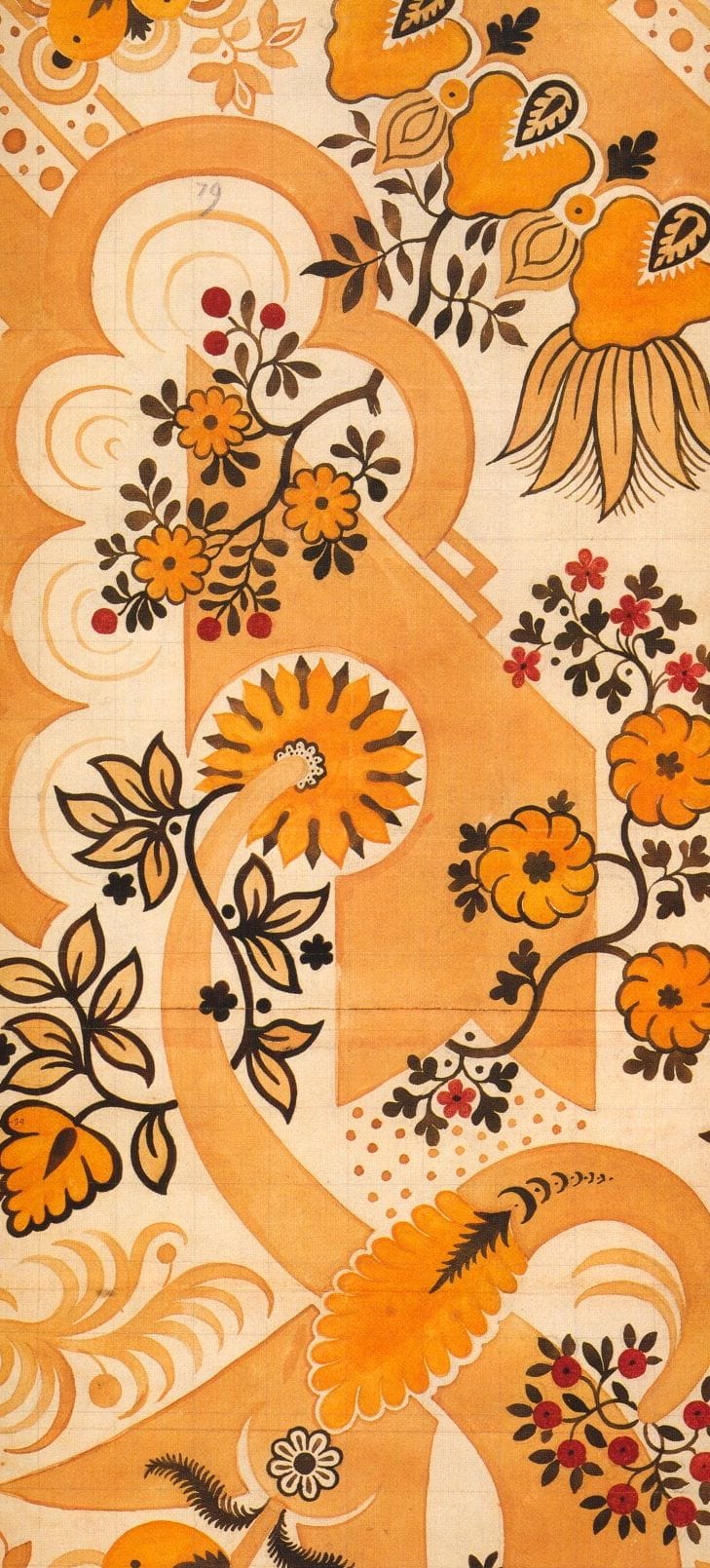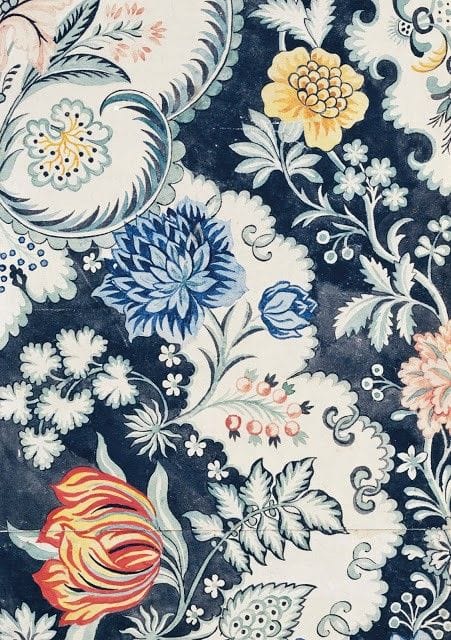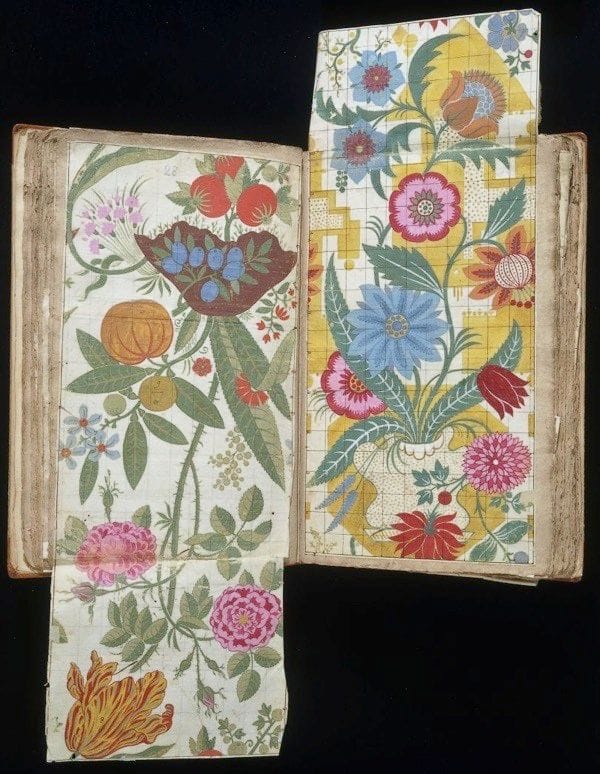20 Nov Book Victoria & Albert Pattern: Spitalfields Silks
I will start teaching my first course on ‘Collaborative Design with Artisans’ as an Adjunct Professor at FIT from the coming Saturday. This new opportunity encouraged me to read about handmade textiles from a global perspective. I read some exciting books from the V&A Museum’s Textile and Fashion collections. It is a very enriching experience to learn from other cultures. This reading and research have helped us enhance our design approach and library at Marasim. As I am hopeful, it will also help further the knowledge of my soon to be students.
V&A Pattern. Spitalfields Silks from London
Today I want to talk about a little book called ‘V&A Pattern. Spitalfields Silks‘ that I just finished reading. It is more of a gorgeous visual directory of the handpainted patterns of silks once developed at a small British town name Spitalfields, located just north of London’s wall. In the eighteenth- century, the area of Spitalfields was an important center for European Silk weaving. The weavers there were highly-skilled, and they produced the most beautiful and expensive silks of the times. Even today, almost three centuries later, these colors and artworks look incredibly appealing and luxurious to me. I am sharing a few designs from the book.





Portrait of a Master Silk Weaver by Michael Dahl, 1720-5 – believed to be James Leman. Image Source
https://spitalfieldslife.com/2020/03/16/james-lemans-album-of-silk-designs/
Since the Spitalfield weavers were close to London, they were near the Royal court and the wealthy diplomats. They were very market savvy. There was a quick absorption of the latest styles. The variety of rich silks brocaded with gold and silver as seen on the portraits of royalty and nobility from the 18th century confirms the quick adeptness of the Spitalfield weavers.
Role of French Huguenots with Spitalfields Silks

Huguenot refugees sat at the centre of the London silk industry. Most of the Huguenots in Britain involved in the silk trades had been merchants, master weavers or journeymen in various textile industries in their former lives in France.
The Spitalfield silks faced tough competition from the silks from France, particularly from the weaver’s based in Lyons. However, it is ironic that many silk weavers in England were French Huguenots who fled the persecution in France, and started their careers as weavers in Spitalfields.
Spitalfields Silks Designers

On the left is James Leman’s design and on the right is a piece of silk woven from it, revealing that colors of the design are not always indicative of the woven textile
Image Source: V&A Museum
Spitalfields ‘ indigenous talents used different weaving techniques to produce various textile types, such as damask brocaded in colored silks or satin ground brocaded with gold threads and details in colored silks. The silk weaving supply chain had 3-4 talented professionals starting from the brilliant pattern drawers, who focused solely on creating beautiful patterns. The drawing has to be feasible to weave on the loom, too; therefore, such work demanded a thorough weaving knowledge. The other professional in the supply chain would transfer this design on a graph mapping design elements to warp and weft.
Once the technical handpainted (mostly using watercolor and ink)graph of the design was ready, then the ‘reader’ (liseuse in France) instructed the lash maker to set up the warp and weft threads on the loom, enabling the weaver to produce the desired pattern.
The Evergreen Designs of Spitalfield Silks
Over the passing of time (decades and centuries), the styles and patterns kept changing. The early 18th century patterns looked ‘Bizzare.’ because of their strange look. They evolved into the ‘Luxuriant’ phase showing nature in an ornamental and symmetric way. Soon the fashion changed, and laces became famous, simultaneously inspiring the Spitalfield silk patterns.
By 1742, they took distinct English patterns featuring local floral sprigs like carnations and auricula, which lay scattered over a pale background. They reflected the English love of gardens. The floral and spring inspirations stayed for a long time. However, there were innovations with the use of metallic silver or gold threads. Spitalfield textiles continue to have enduring appeal even today. The original textile firms that still survive often turn to their company archive to study old designs for their forever eclat.
Read More
MATISSE’S ART AND TEXTILES. HOW TEXTILE STIMULATED HIS CREATIVE POWERS TO A NEW PICTORIAL REALITY
MUGHAL & DUTCH: A CULTURAL BRIDGING OF 2 GREAT ARTISTIC TRADITIONS
MICRO MOSAIC A POPULAR ART FROM THE 19TH CENTURY
FRENCH ART DECO TEXTILE MOVEMENT’S STRONG INFLUENCE ON DESIGN
JACOBEAN EMBROIDERY A STYLE BASED ON THE FOLKLORE OF ENGLAND
ABOUT THE AUTHOR
 Nidhi Garg Allen is an alumnus of Parsons School of Design and Adjunct Professor at the Fashion Institute of Technology. She is a technologist turned artisan entrepreneur and the founder and CEO of Marasim. Marasim based in NYC is committed to preserving artisanal textiles that make use of regional techniques without uprooting craftspeople from their native communities
Nidhi Garg Allen is an alumnus of Parsons School of Design and Adjunct Professor at the Fashion Institute of Technology. She is a technologist turned artisan entrepreneur and the founder and CEO of Marasim. Marasim based in NYC is committed to preserving artisanal textiles that make use of regional techniques without uprooting craftspeople from their native communities




No Comments